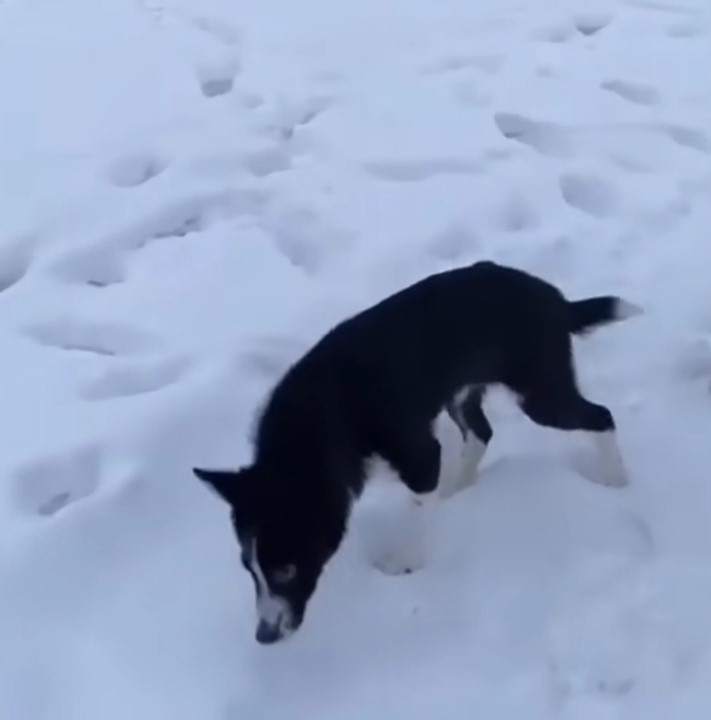I have always imagined how difficult it must be to work in an animal shelter where you have to deal with heartbreak almost all the time, but it’s not always so dark.
There are many joyous moments where so many of the dogs and cats end up recovering and growing stronger than ever before. It’s those moments that really matter to them.
And, it’s really beautiful to see that people like this exist. In the case of this poor puppy, his owner just left him at the shelter and told the staff that he could not care for her.
They were initially confused when he said that the dog was in a car accident, but they wasted no time and decided that they were going to help her.
A Frail Puppy

After the puppy was given to them, they immediately set an appointment at the veterinarian clinic and took her there.
They were careful when transporting her but noticed that something was off. The owner had told them she was in an accident, but they saw no sign of it.
An X-ray confirmed to them that she had no broken bones whatsoever, so that story fell apart. Her blood tests also came back normal. So, what happened?
They noticed that her neck was always tilting to one side, and they decided to do an MRI to confirm what exactly was wrong with her.
The test results showed that she had cerebral oedema and cortical atrophy. This was the cause of her problems.

They determined that she was like this from birth and that her owner probably just didn’t want to take care of her. The head shaking was clearly not from an injury.
She was about four to five months old and had received little medical help to remedy all of her health problems.
However, now was not the time for despair. The shelter staff and the vets were determined to help her lead a normal life.
The dog’s rescuers were baffled by the owner’s lies and couldn’t understand why he would abandon her so cruelly. They tried reaching out, but it was not possible.
A Better Future For Vesta

The vets realized that the pup would likely need surgery, but she first had to go through some form of rehabilitation.
To make things a bit easier for her, they brought her some toys, and she just loved playing with all of them.
She even made a new friend at the shelter. While she was a bit shy at first, she eased up with time and started playing with him.
After finding out that she had autoimmune meningitis and pitting encephalopathy, they realized that those could not be cured.
The best they could do was remedy them long-term. She would also start doing water therapy, which helped her walk more steadily.

After doing tests, the vets gave the shelter staff some good news. The puppy will not need any surgery. Her therapy is doing wonders for her recovery.
This was such a relief for everyone there. She spent half a year trying to recover and the results are really showing.
As for the owner, the authorities found the man responsible, and he just confirmed to all of them that he did not want the dog. While it’s horrible that he thought of her that way, at least she is with someone better now.
One of the rescuers took the dog, now named Vesta, into her home, and she is now enjoying her new life. I am really glad to see everything turn out so well for her.
Have you ever noticed how your furry companion always seems to find their way to your feet, cozying up right there? It’s a common behavior that many dog owners experience but might not fully understand. Your pup’s choice to lay on your feet goes beyond seeking warmth or comfort. Dogs have a unique way of showing affection and loyalty, and this simple act of resting on your feet is a display of their love and bond with you.
Understanding Canine Behavior
Pack Mentality and Bonding
Dogs have a natural instinct to be part of a pack. When your dog decides to lay on your feet, it’s a way of showing that they consider you a part of their pack – their family. This behavior is rooted in their genetic makeup and evolutionary history as pack animals. By being close to you, they feel secure and connected, reinforcing their bond with you as a member of their pack.
Seeking Comfort and Security
Your dog views you as their safe haven. When they lay on your feet, they are seeking comfort and security in your presence. Dogs find reassurance in your scent, warmth, and heartbeat. It’s a comforting and calming experience for them. By staying close to you, they feel protected and at ease, knowing that you are there for them. This behavior demonstrates their trust and reliance on you for emotional support.
The Role of Body Heat and Comfort
Temperature Regulation in Dogs
Dogs regulate their body temperature by lying on your feet. When your pup curls up at your feet, they are using your body heat to stay warm. In the wild, dogs would huddle together for warmth, and by snuggling up to you, they are mimicking this instinctual behavior. Your feet provide a cozy spot for them to soak up your warmth, especially when they are feeling a bit chilly.
Comfort-Seeking Behaviors of Dogs
Your furry friend finds comfort in being close to you. Lying on your feet gives them a sense of security and safety. Dogs are social animals, and being near their loved ones makes them feel content and at peace. Your scent, warmth, and presence reassure them, creating a strong bond between you and your dog. By choosing to lay on your feet, they are expressing their desire for closeness and companionship.
Dominance and Protective Instincts
The Dominance Debate in Dog Behavior
Dog behavior experts have debated the concept of dominance in the human-dog relationship for years. Some believe that when a dog lays at your feet, it’s a sign of dominance to assert their role in the pack hierarchy. However, modern studies suggest that dominance theory in dog behavior may not be as relevant as previously thought. Dogs resting at your feet may simply be seeking comfort and warmth rather than asserting dominance.
Protective Behaviors and Pack Instinct
When your dog lays on your feet, they may also be exhibiting protective instincts and pack behavior. In the wild, dogs huddle together for safety and warmth, and by laying on your feet, your dog might be trying to protect you and stay close for security. This behavior showcases your dog’s loyalty and desire to keep you safe, mirroring the pack mentality where members look out for each other.
Anxiety and Separation Issues in Dogs
Recognizing Signs of Anxiety
If you notice your dog laying on your feet more often than usual, it might be a sign of anxiety. Dogs can seek comfort through physical closeness when they feel stressed or insecure. Keep an eye out for other signs of anxiety, such as excessive barking, pacing, or destructive behavior.
The Importance of Proximity for Anxious Dogs
For anxious dogs, being close to their owners can provide a sense of security and help alleviate their stress. If your dog frequently lays on your feet and follows you around the house, it could indicate their need for reassurance and comfort. Providing a safe and nurturing environment can help reduce your dog’s anxiety levels.
Health-Related Reasons for This Behavior
Joint Pain and Arthritis in Dogs
Dogs, like humans, can experience joint pain and arthritis as they age. When a dog lays on your feet, it could be seeking the warmth and comfort that helps soothe their achy joints. The pressure and heat from your feet can provide relief to their discomfort, making them naturally gravitate towards this spot. It’s a way for your furry friend to find some relief and relaxation, especially if they have underlying joint issues.
The Need for Contact in Older Dogs
As dogs get older, they may crave more physical contact and reassurance from their owners. Laying on your feet is a way for older dogs to maintain that close bond and connection with you. Older dogs, just like senior humans, seek comfort and security, and being close to you provides them with a sense of safety and companionship. So, if your older dog likes to lay on your feet, it’s likely their way of staying close and feeling loved in their later years.
Training and Encouragement
Training Dogs for Personal Space
Training your dog to respect your personal space is essential for a healthy and balanced relationship. Start by establishing boundaries early on, teaching your dog to understand when it’s appropriate to be close to you and when it’s time to give you space. Consistency is key in reinforcing these boundaries, so be firm but gentle in your approach. Use positive reinforcement techniques like treats and praise to reward your dog when they respect your personal space, helping them learn the desired behavior effectively.
Positive Reinforcement and Behavior Modification
Positive reinforcement is a powerful tool in shaping your dog’s behavior. When your dog lays on your feet, encourage and reward them for positive behaviors such as calmness and proximity without invading your personal space. Redirect any unwanted behavior gently but firmly, showing your dog what is acceptable while providing them with affection and attention when they behave appropriately. This approach helps your dog associate laying near your feet with positive experiences, strengthening your bond and reinforcing desired behaviors effectively.
Conclusion
So, next time your furry friend plops down on your feet, remember it’s not just about warmth or dominance. It’s a way for them to show love, seek security, and be close to you. Understanding your dog’s behavior can strengthen your bond and create a harmonious relationship. Keep nurturing that connection through positive training methods and setting boundaries. By respecting their need for comfort and space, you’ll continue to build a trusting and loving companionship with your loyal canine buddy.
Frequently Asked Questions
Why do dogs like to lay on their owner’s feet?
Dogs lay on their owner’s feet as a sign of affection, loyalty, and pack behavior. It provides them comfort, warmth, security, and a sense of closeness to their owner.
Does a dog laying on my feet mean they are trying to assert dominance?
No, dogs laying on their owner’s feet usually symbolize comfort and warmth rather than dominance. It shows a strong bond, protective instincts, and a desire to be close to their human.
Are there any health-related reasons why a dog may lay on my feet?
Yes, older dogs may lay on their owner’s feet to alleviate joint pain and arthritis. The warmth and comfort provided by laying on feet can help soothe achy joints and provide relief.
How can I train my dog to respect my personal space?
Training your dog to respect personal space involves establishing boundaries, using positive reinforcement, and encouraging calm behavior. Consistent training and reinforcement help reinforce positive behaviors while strengthening the bond between you and your dog.
[no_toc]

Hey there, I’m Janet Brooks, a dog-loving student from California. I’m all about helping pups in need, especially those without homes. Me and my awesome friends work together to give shelter and love to stray dogs. Oh, and I also write blogs about dogs to share helpful info.